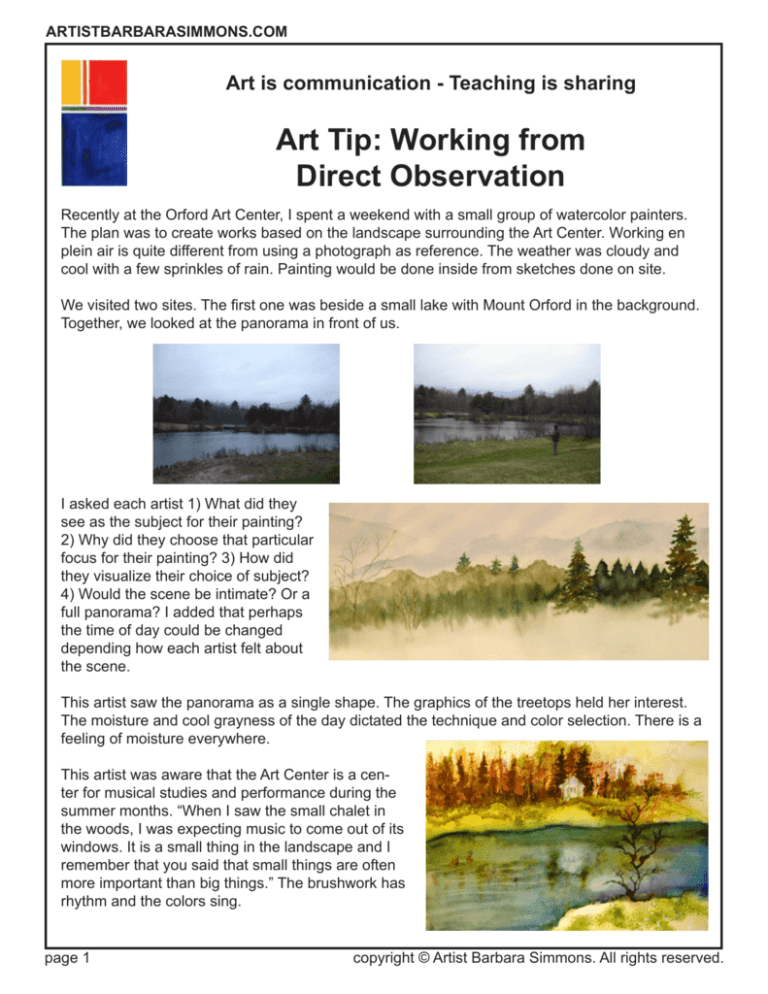
ARTISTBARBARASIMMONS.COM
Art is communication - Teaching is sharing
Art Tip: Working from
Direct Observation
Recently at the Orford Art Center, I spent a weekend with a small group of watercolor painters.
The plan was to create works based on the landscape surrounding the Art Center. Working en
plein air is quite different from using a photograph as reference. The weather was cloudy and
cool with a few sprinkles of rain. Painting would be done inside from sketches done on site.
We visited two sites. The first one was beside a small lake with Mount Orford in the background.
Together, we looked at the panorama in front of us.
I asked each artist 1) What did they
see as the subject for their painting?
2) Why did they choose that particular
focus for their painting? 3) How did
they visualize their choice of subject?
4) Would the scene be intimate? Or a
full panorama? I added that perhaps
the time of day could be changed
depending how each artist felt about
the scene.
This artist saw the panorama as a single shape. The graphics of the treetops held her interest.
The moisture and cool grayness of the day dictated the technique and color selection. There is a
feeling of moisture everywhere.
This artist was aware that the Art Center is a center for musical studies and performance during the
summer months. “When I saw the small chalet in
the woods, I was expecting music to come out of its
windows. It is a small thing in the landscape and I
remember that you said that small things are often
more important than big things.” The brushwork has
rhythm and the colors sing.
page 1
copyright © Artist Barbara Simmons. All rights reserved.
ARTISTBARBARASIMMONS.COM
Working from Direct Observation continued
The second site was a pathway through the
woods. It was cool and gray and the sounds came
from the forest itself. As we
walked and talked, our feet
made crackling noises as we
walked over the dried leaves
and twigs.
This artist saw the forest
interior as an evening scene.
The spring run off acted as
a pathway into the interior. Backlighting pulls the viewer into the painting. It
touches every man’s emotions.
Looking at the same scene, I looked downwards to find my focus
for the sketch. I always look for water and I saw an opportunity to
create a movement through the forest. I too, will use backlighting
for the watercolor.
This artist had a
fear of painting birch
trees. They are very
often left too white and look artificial. As can be
seen in the photo, there were other trees, but she
only saw the birch trees. “I saw the scene like that”.
When working at a plein air site, focus on only what
is interesting to you at that moment. By using the
sketch as your reference material, you will create
an original and well-designed work of art.
This dead tree stump caught
the eye of two of the artists.
The first artist saw the trunk
as rich in texture. It was an
isolated form in the forest, a
venerable old tree.
The color made the second
artist stop. She noticed the
texture and the wood fiber.
Each artist chose to paint
only the tree trunks, but each work is very different in color and technique. We can all look at the
same subject and each of us can express it in a different way.
One of the joys of making art is to walk in the nature that you will paint. It is a way of becoming
acquainted with your subject. You can walk around the subject; you can look at it from a standing
position; you can sit on a rock and look at it from that lower level. Go outside to sketch or sketch
from a live model and then create a work from your personal sketches.
page 2
copyright © Artist Barbara Simmons. All rights reserved.









